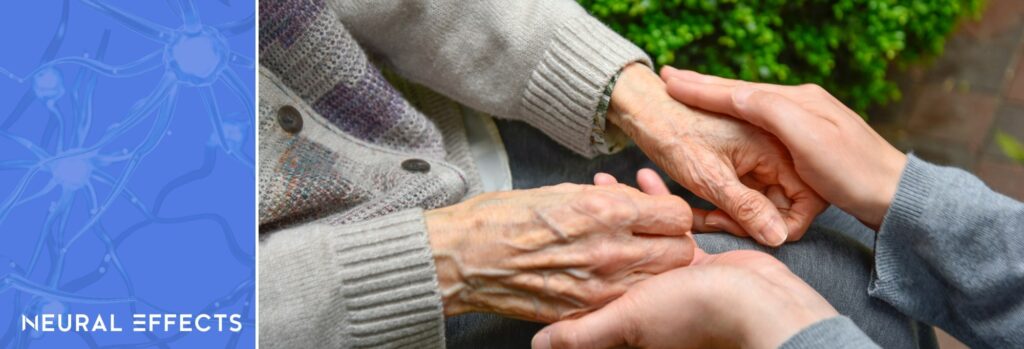Therapeutic activities — which can include everything from joining an exercise class to playing a board game to having a barbecue with friends and family — can be tremendously valuable and enriching for patients with dementia, helping them to feel happier, more relaxed, and healthier.
In addition, regularly engaging in therapeutic activities can improve physical and cognitive function, which can slow down disease progression, improve quality of life, and improve the patient’s ability to carry out their daily tasks.
In this post, we share 32 therapeutic activities that family members and caregivers can use as inspiration for choosing activities to do with their loved ones. Whenever possible, we recommend encouraging the patient to choose what they want to do, providing them with a sense of autonomy and meaning in the ways they spend their time.
To make things easy, we’ve broken down the list of activities into the following categories:
Note: To further boost your loved one’s chances of delaying symptoms, we recommend a combination of physical exercise and cognitive therapy. This approach — which we offer at our clinic, Neural Effects — is an evidence-based way to influence cognition and behavior positively in early-stage dementia. After discussing the list of activities below, we’ll walk through our treatment program and explain how we help patients and caregivers maintain autonomy and quality of life for as long as possible. If interested, you can jump straight to that section.
Neural Effects uses the latest evidence-based techniques to diagnose and help patients with dementia. We are located in Provo, Utah, and serve anyone in Salt Lake City or the Utah Valley area. We are in-network for most types of medical insurance. Schedule your evaluation today.
How Can Therapeutic Activities Help Dementia Patients?

Engaging in meaningful therapeutic activities can help alleviate various dementia symptoms, improve patients’ quality of life, and ensure that their needs are being met. Activities also play an important role in dealing with challenging behaviors, helping caregivers soothe or distract patients when they are restless or distressed. These activities can be useful for patients in different stages of dementia (early, middle, and late-stage) and with different types (Alzheimer’s disease, frontotemporal dementia, Lewy Body dementia and others).
Overall, therapeutic activities provide patients with:
- A sense of purpose
- A way to use skills and life experiences
- A way to promote self-esteem
- An opportunity to socialize with friends and family
- A way to live independently for longer
- An opportunity to make decisions
- A way to improve physical and cognitive skills
- A way to help maintain the ability to perform activities of daily living (ADLs)
- A way to feel more productive
Tips to Consider When Planning Activities
If you’re caring for someone with dementia, it can be challenging to think of different activities to do day after day. Here are a few tips to help you choose:
- Timing must be right: To achieve the most success when carrying out activities, caregivers need to consider the time of the day when the patient is most alert. For example, some patients will enjoy going for a walk first thing in the morning, while others may prefer to stay at home with a cup of tea, reminiscing and looking through old photo albums. It’s also important to make sure the patient isn’t worried about something. If they are, they will not be able to concentrate on the task.
- Activities must be enjoyable and engaging: Activities that are fun and engaging can reduce disruptive behaviors, such as frustration or agitation. Activities such as music, arts and crafts, or sensory stimulation are ideal. Also, patients with dementia may enjoy going out for the day, even if they later don’t remember where they were. What is important is that they enjoyed themselves while they were out, even if the experience is soon forgotten.
- Activities must be stimulating: Picking stimulating activities is crucial to help patients stay active physically and mentally. What each patient considers stimulating and engaging will vary. A good way to find the right activities is to do things patients liked doing in the past. For example, if your loved one was a keen gardener, they may still enjoy spending time in their garden. Or, if they always enjoyed going for a coffee and reading the newspaper in the morning, they may want to continue that even if they can’t completely read the paper. The key is to find the right balance: Activities need to be stimulating enough to keep the patient focused but not so difficult that the patient becomes frustrated or annoyed.
- Activities must be adapted to the patient’s abilities: As the patient’s abilities change throughout the disease, caregivers need to adapt and adjust the activities to suit what they can do. For example, patients in the early stages of dementia can engage in challenging cognitive games, whereas patients in the later stages may need more comforting activities, such as listening to music. In addition, elderly patients may have pre-existing conditions, such as heart problems, arthritis, or high blood pressure, which may limit some of the activities they can do, especially if they involve physical exercise.
- Activities must be conducted in a safe and comfortable environment: This is particularly relevant for activities you do at home. Patients with dementia often experience vision problems, including difficulty with visual perception and coordination. To avoid accidents and falls, ensure that any work surfaces are clean and clutter-free and that the room has good lighting. Also, during the activity, avoid distractions and keep noise low as much as possible.
How You Can Help as a Caregiver
Here are a few tips to keep in mind as you conduct dementia activities with your loved one:
- Help get the activity started: Patients with dementia still have the desire to do things but may need help with planning and starting activities.
- Offer support: Offer as much support as needed to carry out your activities. The best way is to provide simple and easy-to-follow steps. Too many directions at the same time can be overwhelming.
- Focus on the process, not the result: It doesn’t matter if the table isn’t set properly. What matters is that your loved one engaged in an activity at home with the rest of the family and felt useful.
- Be flexible: If your loved one insists that they don’t want to do something, don’t force it. Likewise, if the activity turns out different from what you had planned, encourage them to continue anyway.
- Help with the difficult parts of the activity: If you’re cooking with your loved one, for example, they may need help measuring ingredients or reading the recipe. Find a way to help with the difficult parts and suggest something else they can do instead.
- Let your loved one know they are needed: Throughout the task, ask for your loved one’s help so that they know they are needed.
- Never criticize or correct your loved one: Allow your loved one to carry out the activity as they wish, even if you think it’s the wrong way. As long as it’s safe, encourage them to continue.
- Allow self-expression: Include activities that allow your loved one to express their ideas and feelings. Painting or listening to music are ideal activities for this.
- Keep the conversation going: Whatever activity you pick, keep the conversation with your loved one. Even if they can’t respond (as the disease progresses), they will still enjoy hearing your voice.
- Try again later: If something you had planned is not working, try again later. It may be the wrong time of day, or your loved one could be worried about something.
- Be encouraging: Encourage your loved one to keep engaging in different activities to provide mental stimulation.
- Be ready to adapt: Always be ready to adapt your planned activity, if needed. For example, instead of just listening to music, your loved one may want to dance as well.
- Allow your loved one to choose the activity: Whenever possible, allow the patient to choose what they want to do. They are more likely to engage in the activity if they pick it themselves.
Physical Activities
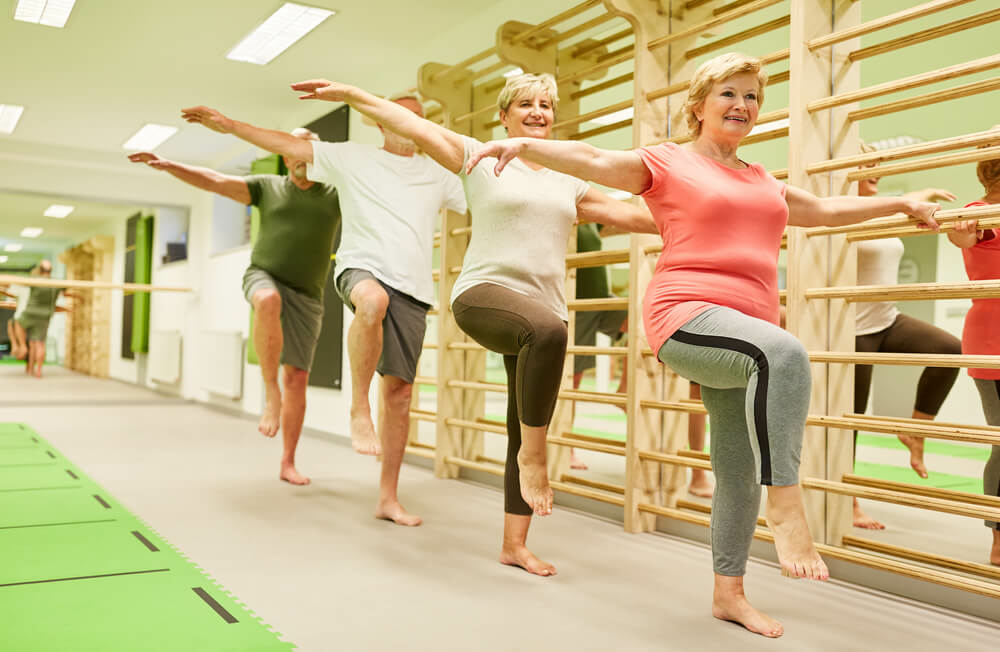
Physical exercise offers numerous benefits for patients with dementia, enhancing their overall health through improved cardiovascular fitness, strength, and endurance. It can also slow down dementia-related symptoms, including cognitive decline and sleep disturbances. Regular physical activity is key to maximizing patients’ independence for as long as possible.
Regular exercise can provide many health benefits, including:
- Improved mood
- Better sleep
- Improved motor skills
- Reduced risk of falls
- Improved strength
- Improved balance
- Improved memory and other cognitive skills
- Improved behavior, such as reduced rate of wandering, swearing, and acting aggressively
- Better communication and social skills
- Reduced risk of heart disease and diabetes
- Reduced stress
- Improved self-sufficiency and self-confidence
Especially for older adults who didn’t engage in exercise when they were younger, engaging in physical exercise can be a daunting process. Caregivers can help by following these safety tips:
- Discuss with the patient’s doctor about what type of exercise they can do, especially if patients have pre-existing conditions that may limit their mobility. Some patients may need a full medical check-up.
- Take things slowly. At first, patients may only be able to do five minutes of gentle exercise, but over time, they can gradually increase what they do.
- Engage in the exercise at the same time as the patient. If it’s a series of different exercises, caregivers can demonstrate and ask the patient to follow.
- Make the activity interesting and engaging. If patients feel bored (because it’s too easy) or overwhelmed (because it’s too difficult), they are less likely to feel motivated to continue.
- When you’re outside, make sure the patient is wearing a medical alert bracelet and identification in case they wander off and get lost.
- If the patient is fit enough to talk while exercising, keep the conversation flowing as much as possible. This keeps the patient engaged, and you can monitor how tired they’re getting.
- If you’re going out in the summer, make sure the patient is wearing a hat and applying sunscreen to all exposed areas of their skin.
- Make sure the patient drinks plenty of water during exercise to avoid dehydration.
- If the patient complains of dizziness or any kind of pain, stop the activity.
1. Go for a Walk
Walking is one of the best exercises patients can do, and it’s free. In addition, it can be combined with other tasks that caregivers need to do, such as going shopping or taking the dog for a walk. Walking also helps control some disruptive behaviors, and patients are less likely to wander off if they know they are going for a walk.
Ideally, patients should walk 4–5 times per week for 30 minutes with minimal breaks. When this becomes a problem, patients can still engage in several short walks during the day, even if it’s just around the garden. Always make sure the patient is wearing comfortable shoes and lightweight clothes.
2. Go for a Bike Ride
Some patients may enjoy going out on a bike ride. Even patients in the more advanced stages of the disease — as long as they don’t have problems with balance — can enjoy a bike ride at a leisurely pace. Caregivers must stay close to avoid patients becoming distressed.
If patients don’t feel confident going alone on the bike, tandem bikes allow caregivers to sit in the front and control the bike while the patient sits in the back and pedals.
3. Exercises to Improve Balance
It’s common for patients with dementia to experience dizziness and other balance problems. Balance exercises can reduce the risk of falls and help maintain independence for longer. In addition, these exercises help the vestibular system, strengthen muscles associated with balance, improve cognitive function, and generally make activities of daily living easier to perform.
You can read in more detail about exercises to improve balance in a previous post, but some suggestions include:
- Leg stances: Stand with both feet together in a corner or against a counter for safety. For an added challenge, stand with one foot in front of the other in a straight line.
- Rock the boat: Lean slightly from side to side and lift a leg off the floor gently.
- Side steps: With eyes closed, take 10 steps sideways to one side and then 10 steps to the other side.
- Hip kicks: Kick a leg forward and then to the side, keeping the knee straight. Repeat with the other leg.
4. Exercises to Improve Resistance
Resistance training usually involves lifting weights or pulling against resistance bands to improve muscle strength and endurance. A study found that six months of strength training in patients with mild cognitive impairment (MCI) improved cognitive performance and protected some areas of the brain against further degeneration and shrinkage. Notably, the benefits were still visible a year later. Some of these exercises can be quite strenuous and are not suitable for everyone. If your loved one is not physically fit, consider modifying the exercises to make them less difficult or pick a different activity.
Similarly to balance exercises, we’ve written in more detail about how to carry out these exercises. Some suggestions include:
- Squats
- Lunges
- Deadlifts
- Push-ups
- Chin-ups
- Plank
- Calf raises
5. Yoga and Tai-Chi
Yoga and tai-chi have many benefits for patients with dementia, including physical, cognitive, and emotional benefits. Some of these include:
- Improved bone strength, balance, and flexibility
- Reduced risk of falls
- Increased respiratory, cardiovascular, and circulatory health
- Reduced stress
- Improved sleep and increased feelings of restfulness in the morning
- Lowered risk for depression and anxiety and improved mood
- Improved cognitive skills, such as memory, attention, awareness, thought, and language
Patients who are new to yoga and tai chi can start with very simple maneuvers adjusted to their fitness level. YouTube is a good place to find videos with different exercises that are easy to follow at home. Some community groups offer sessions for elderly patients.
6. Seated Exercises
Seated exercises are a popular choice for patients with mobility issues who may not be able to engage in other forms of physical exercise. Patients can exercise safely sitting on a chair or even the sofa.
Ideally, caregivers should also do the exercise, allowing patients to follow along and stay engaged. It may also help to add some music to make it easier to flow from one exercise to the next.
Some examples of seated exercises include:
- Holding a ball or a small cushion in one hand, then, while rotating at the waist, moving the ball to the other hand
- Marching to the rhythm of the music
- Keeping heels on the floor and bending over to tap each set of toes
- Lifting arms out in front, then raising them to the ceiling and wiggling hands and fingers
- Using the arms of a chair if needed, try to slowly raise to a standing position
7. Exercises in the Swimming Pool
Exercise in the water is an excellent form of physical activity for patients with dementia. This is especially true if they’re also suffering from musculoskeletal injuries, chronic inflammatory conditions such as arthritis, or recovering from recent surgeries.
Low-impact exercises in the water are gentle on muscles, bones, and joints and help patients improve flexibility and perform movements that they could not do otherwise. These exercises also improve memory and cognitive function, as well as reduce symptoms of depression. Joining a program for elderly patients is a good way to socialize and interact with others.
If there are no sessions available in a swimming pool near you, patients can engage in water aerobics on their own or with friends or family. Just make sure that someone nearby knows they are in the pool in case of an emergency.
We’ve written in more detail about water exercises in another post, but some suggestions include:
- Leg swings: Chest deep in water, patients swing one leg at a time like a pendulum. Repeat with both legs.
- Mini squats: Patients should bend their knees as much as possible, like sitting in an invisible chair.
- Marching: Patients can pretend they’re marching on the spot.
- Arm circles: Patients should be about neck deep in the water and make circles with their arms. Start with small circles and then gradually increase.
8. Dancing
Patients can dance anywhere. This activity can be as structured (by following specific dance moves) or as free as patients want. It’s ideal to boost physical, mental, and emotional well-being. Studies also show that dancing can improve strength and muscle function, as well as balance, flexibility, and cardiovascular health.
In addition, dancing to their favorite songs also provides an opportunity to reminisce and discuss happy memories from past events. Some patients may enjoy more organized events, such as dancing lessons at a local community club.
9. Go Out and About
It’s easy for patients with dementia to feel bored at home. Going out for the day can be a great way for patients with dementia to engage with the world around them and experience new things. It also provides an opportunity to engage in physical exercise, relieves symptoms of depression and anxiety, and minimizes disruptive behaviors, such as aggression and agitation.
Suggestions for a day out may include:
- Going shopping together
- Visiting their favorite place around town
- Visiting local monuments or other places of interest
- Going to the cinema or theater
- Visiting museums or art galleries
- Visiting family and friends
It may be useful for caregivers to know in advance what services are available. Some places organize activity days specifically for patients with dementia, such as shorter theater performances or guided visits during quiet times.
10. Explore Nature
Similar to going out shopping, exploring nature is a great way to get patients with dementia out of the house. There are many stimulating outdoor activities that your loved one can do. This is particularly good if your loved one enjoyed activities like gardening or had a love for wildlife.
Activities to consider include:
- Gardening (more about this one later)
- Visiting a local botanical garden
- Going for a walk or a bike ride in the park
- Going bird watching at the local nature reserve
- Feeding birds or ducks in the pond
- Simply sitting in the garden and watching the birds
- Watching a nature documentary (especially good for rainy days)
Activities focused on nature are a fantastic way for patients with dementia to stay physically active, feel less anxious, and feel a sense of enjoyment. Even just going for a walk in the park can provide different sensory experiences, such as different sounds and smells, and can help improve mood and cognitive function.
It’s important to check that these activities are safe and accessible for patients with dementia. Some patients may require mobility assistance or other accommodations to participate fully in these activities.
11. Help with Household Chores
Sometimes, caregivers struggle with finding time to plan activities for their loved ones. Even just participating in family life and helping with household chores can make the patient feel valued. The familiar tasks can also evoke comforting memories and can trigger a conversation. These activities need to be tailored to the patient’s abilities to make sure they feel engaged and productive without being overwhelmed.
Examples include:
- Folding laundry, such as towels and socks
- Setting the table
- Washing the dishes
- Sweeping the floor
- Sorting mail
- Sorting out recycling items
12. Travel and Go on Vacation
Traveling and going on holiday can be a great way to relax and have new experiences. It’s still perfectly safe for patients with dementia to travel and go on holiday after their diagnosis, but it may need a little more planning. It may be easier to go on short journeys to familiar places. Long-distance travel can be tiring and confusing, especially for patients in the later stages of the disease.
Cognitive Activities
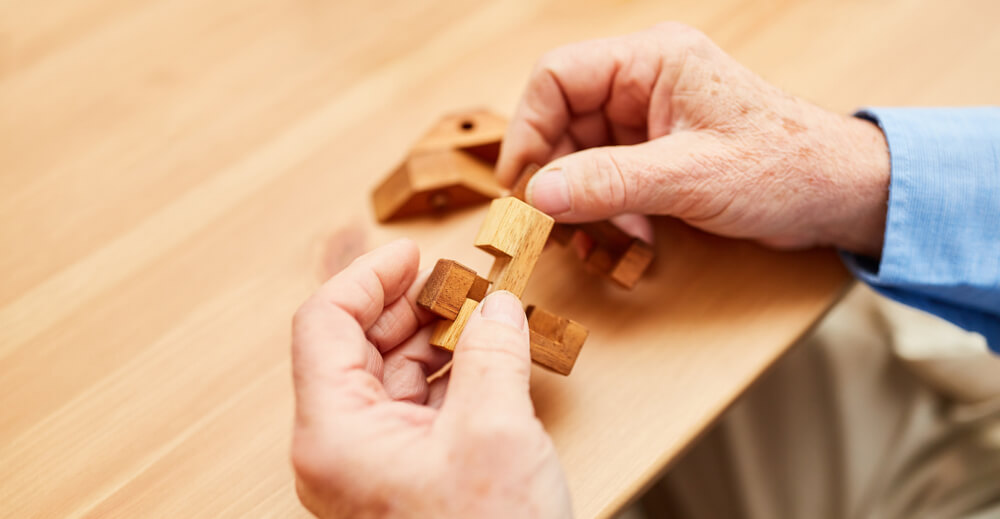
Cognitive activities can protect (and in some cases improve) cognitive skills in patients with dementia. Any activity that challenges the brain and helps patients improve one or more cognitive skills can be considered a cognitive activity. Many studies show that patients with dementia who engage in these types of activities perform better across all cognitive areas, including memory, thinking, reasoning, attention, problem-solving, and others.
13. Cognitive Games Used in Therapy
Cognitive stimulation therapy — a core aspect of dementia treatment at Neural Effects — uses many different activities to help stimulate cognitive function and slow down the progression of symptoms.
Many of these engaging activities don’t require any special equipment and can easily be adapted to do at home:
- “Guess the….” game: There are many different variations possible for this game, including guessing the song, the flag, the state, and many others.
- Story dice: Patients have to make up a story based on the pictures on a dice. Patients roll the dice and have to come up with an impromptu story.
- Trivia questions: Patients need to answer questions about general knowledge, such as capital cities or famous people. This activity improves cognitive abilities, such as memory, reasoning, and problem-solving. It also promotes communication skills and social interaction.
- Money: Patients have “money” and they have to “buy” different products. This activity helps patients with decision-making when they determine what they can afford to buy and with mental math when they need to check the change after making a purchase.
14. Play Board Games or Card Games
Board games and card games are a great way to spend time together when the weather outside isn’t great or for patients with serious mobility issues. They encourage communication and strategic thinking, as well as stimulate memory and cognitive skills in a fun and engaging way. It’s crucial to pick a game that the patient can play without becoming confused or frustrated.
Examples include:
- Dominos
- Bingo
- UNO
- Chutes and Ladders
- Checkers
- Solitaire
- Scrabble
- Jigsaw puzzles
- Guess Who?
- Battleship
- Trivial Pursuit
15. Play Brain Teasers
Like board games, brain teasers help protect against memory loss and stimulate cognitive function, as well as provide opportunities for social interactions to help patients and caregivers create positive emotional connections. For example, a study showed that playing crossword puzzles regularly delayed cognitive decline in patients with dementia compared to those who didn’t play.
Activities appropriate for patients with dementia include:
- Jigsaw puzzles
- Find-a-Word puzzles
- Mazes
- Phone apps for brain training
- Sudoku
16. Look at Old Photos and Videos
Looking at old photos and videos helps patients with dementia think about events that occurred in the past. These albums are filled with photos from their younger years and can help reignite precious memories. It also helps improve quality of life, cognition, communication skills, and mood, and it’s a great way to find out something you possibly didn’t know about your loved one.
Here are a few suggestions:
- Go through old photo albums
- Watch old family videos
- Watch old television programs that patients remember from their youth
- Use old photos to research family history
- Use Google Maps to “visit” places from their younger years and discuss how much they’ve changed
17. Make Memory Boxes
Another activity that patients with dementia may enjoy is making memory boxes or memory books. This also involves recalling past events, which can enhance mood and offer a stimulating, meaningful activity to share with a family member.
Creating memory boxes or books — also called scrapbooking — can be as diverse as the patient wants and can contain a variety of personal objects, such as photos, mementos from holiday trips, small toys, a packet of the patient’s favorite cookies, and much more. Each item that goes in the box can trigger a conversation as to why it’s included and what happy memories it brings.
18. Read a Book
Whether fiction or nonfiction, reading can be a great way for patients with early dementia to improve their communication skills. This is particularly true if your loved one used to be an avid reader. For patients with late-stage dementia who may struggle to read, caregivers or other family members can read to them. This can be a nice activity for children to do with their grandparents, for example. If the patient finds it difficult to concentrate for a long time, try short poems or picture books that the patient enjoyed before. Reading these can bring back memories and start conversations.
Alternatively, patients can listen to their favorite book as an audiobook. This can be a better alternative to television in the evening or can be used during travel to keep the patient relaxed.
19. Watch a Movie
Watching movies is another great way to stimulate the patient’s cognitive skills and increase feelings of connectivity with the rest of the family. Each patient has their preferences, but often, patients with dementia react well to movies that do not have complex storylines, such as comedies or musicals.
20. Tell Jokes and Laugh Frequently
Keeping a good sense of humor can help patients with dementia. A few years ago, a study — appropriately called the SMILE study — showed that if caregivers told the patients funny jokes and made them laugh frequently, it helped reduce levels of anxiety and agitation and promoted a better relationship between patient and carer. Patients and caregivers may make up their own “family” jokes or watch stand-up comedy shows, for example.
21. Engage with Younger Members of the Family
Any new activity that connects patients with younger members of the family can provide enormous benefits for both groups. Spending time together is an ideal way to reduce feelings of loneliness and isolation, as well as to develop empathy and compassion among the younger generations.
These activities can be as simple as reading a book, watching television, or playing games together. These interactions stimulate cognitive function for patients with dementia and provide new learning opportunities.
22. Sort Items
This is an activity for patients with moderate to late dementia. As a way to help fine motor skills and cognitive function, patients try to sort a series of small items according to color, size, shape, etc. Some patients may find it interesting to spend some time finding the right objects for this game, which in turn may spark some conversation with the caregiver.
Objects may include:
- Buttons
- Colorful beads
- Bottle caps
- Jewelry
- Cards
- Rocks
- Nuts and bolts
- M&Ms or other colorful sweets
23. Keep in Touch with Friends and Family
With today’s technology, it’s easy to stay in touch with friends and family, even if they live far away. This is the perfect opportunity for patients with dementia to call members of the family whom they may not see frequently in person. In addition, learning to use computers or tablets also helps slow down cognitive decline and helps patients keep up with technology.
Patients can:
- Send emails
- Use instant messages
- Make video calls (such as on Skype and Zoom)
- Have a social media presence (such as Facebook and Instagram)
- Join online communities
- Play online games with others
24. Find Local Support Groups
Joining a local support group is a good way to meet other patients with a similar diagnosis and engage in different activities. Popular activities include singing, playing musical instruments, drama classes, arts and crafts, and many others. It’s important to find a group that you enjoy. This could be a faith-based group, a reading group, or a creativity group, for example. Being part of these groups can give patients a sense that they’re not alone and they belong somewhere.
Sensory Activities
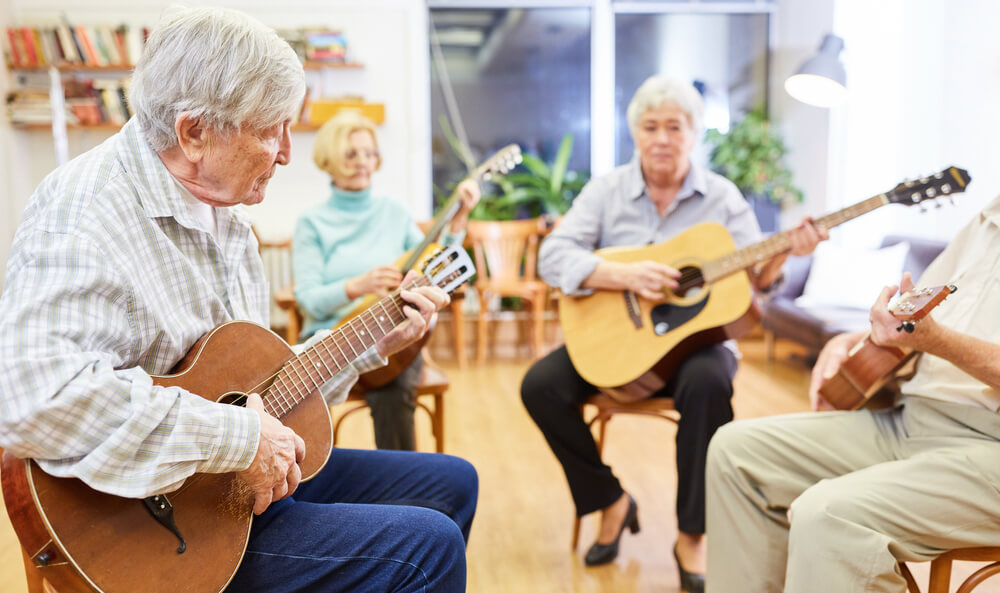
In general terms, sensory activities can be very helpful to treat cognitive impairments and improve quality of life. These activities offer patients different ways to engage all five senses, using everyday objects that can trigger positive thoughts, memories, or feelings. Sensory activities are especially valuable for those patients who may struggle to connect with the world around them.
Sensory activities can:
- Help patients feel safe and relaxed
- Improve the patient’s mood and self-esteem
- Increase communication, concentration, and other cognitive skills
- Provide opportunities for socialization
25. Cooking
For many patients, the kitchen is a familiar place that holds many good memories. Being involved in cooking a meal for the family can help patients reminisce and recall funny stories. Cooking is also the perfect sensory activity, with different smells, textures, and flavors to experience.
Depending on their abilities, your loved one may be able to create an entire recipe by themselves, or they may need help with the more complex steps. Even if they are in the later stages of the disease and cannot perform any of the steps, they still benefit from being in the kitchen watching you cook.
26. Gardening
Many patients with dementia had a garden at some point in their lives and enjoyed spending time there. Gardening — even if it’s looking after small plants indoors — is a great way to stimulate the mind and awaken all the senses. Dealing with plants has a calming effect, evokes memories, and stimulates social interactions and well-being. It also improves sleep, reduces agitation in patients with dementia, and supports a wide range of physical activities, from light exercise such as weeding or raking to more strenuous digging and cutting trees.
From a practical point of view, if your loved one is struggling to bend, it may be advisable to invest in raised beds to make them more accessible from a standing or sitting position.
27. Music
Music is a great activity for patients with dementia. Studies show that music reduces feelings of anxiety and depression and improves behavior. Music can be beneficial even in the later stages of the disease, as musical memories are retained even after other types of memory are lost. This is because some of the key areas in the brain involved with musical memory are often the last ones to be affected by the disease.
Ways in which music can be used as an activity include:
- Creating playlists for different occasions, such as helping relax before bedtime, providing a distraction when a patient is distressed, or motivating physical exercise.
- Encouraging patients to sing along to songs they like. If possible, patients may also want to dance.
- Playing “Name That Tune.” This requires some preparation to compile a series of songs that the patient is familiar with and let them try to guess the name of the song and artist.
- Allowing patients to experiment with different sounds. Patients can play with musical instruments or even make their own from household items.
28. Sensory Boxes
Making up sensory boxes helps cognitive skills and offers tactile stimulation for the patients. Patients and caregivers can collect a variety of items to put in the box. Ideally, items should have different textures, colors, sizes, etc.
Suggestions to put in the box include:
- Feathers
- Beads
- Fidget spinners
- Cotton balls
- Playdough
- Stress balls
- Small wooden objects
- Small toys
29. “Stop and Smell the Roses”
Scents can trigger powerful memories because they’re processed in the brain near the areas that control memory. When you go out with your loved one, encourage them to notice familiar scents, like fresh-cut grass or the aroma of freshly baked bread. It’s important to avoid smells that can trigger bad memories and cause distress.
Creative Activities
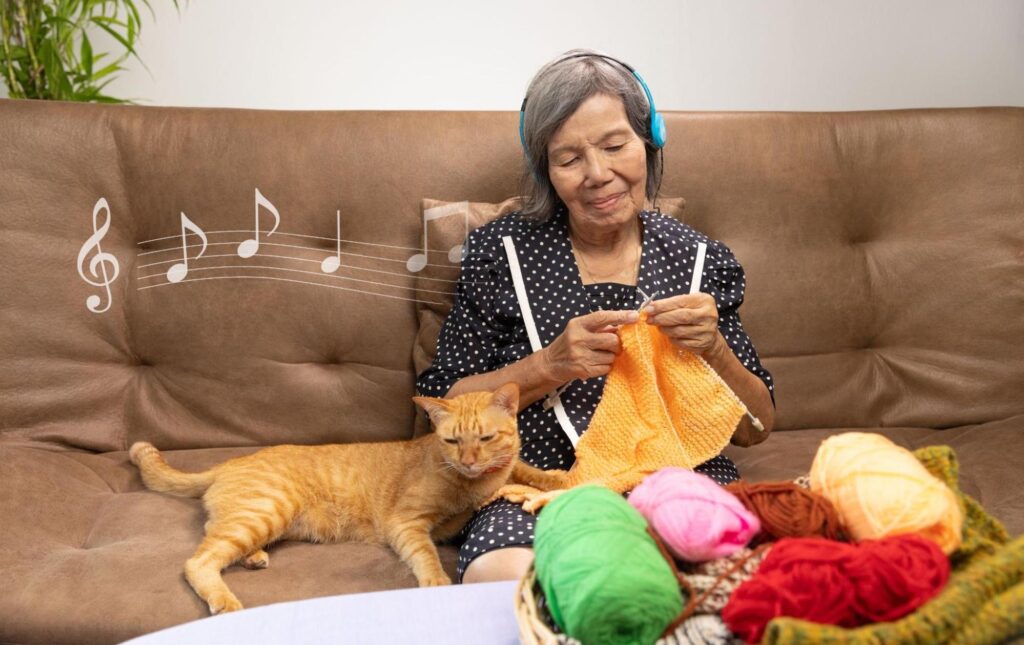
Creative activities have numerous benefits for patients with dementia. Crucially, patients who are in the later stages of the disease and may struggle to talk can use creativity as a way to express their feelings in a non-verbal way. Patients with dementia can sometimes speak a few words or smile while they’re painting, even if they normally aren’t able to.
Additionally, creative activities give patients a sense of accomplishment and purpose because they’ve managed to produce something despite the limitations caused by the disease. This also helps reduce stress and relieve symptoms of depression and anxiety.
30. Arts and Crafts
Art therapy is one of the most valuable types of therapy for patients with dementia. Studies show that it improves cognitive function, reduces disruptive behaviors, and promotes better communication between the patient and their caregivers. Arts and crafts are also a great way to encourage creativity and give patients a sense of achievement.
Some ideas include:
- Painting and drawing: Patients don’t need to be artists to enjoy painting and drawing to express their feelings creatively. This is their opportunity to use bold and bright colors. Patients in the later stages of the disease can use painting as a form of non-verbal communication.
- Adult coloring books: These books are particularly useful during travel times or if the patient has to wait for a doctor’s appointment, for example. They’re popular for stress relief and can easily be found in craft shops or online.
- Crochet and knitting: Even simple items like a scarf or hat can be very satisfying to complete.
- Collages: Patients can use cut-out images from magazines or even family photos to create a collage. They can choose a theme to fit their interests, such as cooking, gardening, or cars.
- Keeping up with seasonal traditions: This can include, for example, making decorations for the Christmas tree, coloring Easter eggs, or carving a pumpkin for Halloween.
31. Build a Memory Box
Patients with dementia may enjoy building a memory box with items that hold a special meaning to them. For caregivers, it’s the perfect opportunity to engage with the patient and ask questions about the items they pick.
The box may include:
- Photographs of family and pets
- Special mementos
- Items that remind the patient of their profession, such as stationery items for somebody who used to work in an office or nuts and bolts for a handyman
- Items related to favorite hobbies
- Items related to favorite sports team
- Items related to favorite holiday
- Items marking important events in the patient’s life
32. Create Themed Boxes
Similar to sensory boxes, patients with dementia may enjoy collecting items to create their themed boxes. They can come back to the box again to add more items or use it as a gift for a friend or relative.
Some themes to consider are:
- Garden Box: Patients who used to be keen gardeners may want to collect seed packets, small garden tools, pebbles, or even soil for their gardening bin.
- Sparkly Box: Patients may want to find sparkly items around the house, such as jewelry, coins, and items with glitter, for example.
- Sports Box: Sports fans may want to collect hats, key chains, playing cards, and pictures from their favorite sports team.
- Holiday Box: If patients have just been on vacation, they may want to collect items related to the place they’ve visited, like seashells, pebbles, and postcards.
- Arts and crafts box: Patients who enjoy painting or drawing may find it interesting to collect different craft materials, such as paint, clay, sponges, etc.
- Aromatherapy box: Patients may wish to collect different scented oils and lotions to use for different occasions.
Getting Additional Support Through a Dementia Clinic
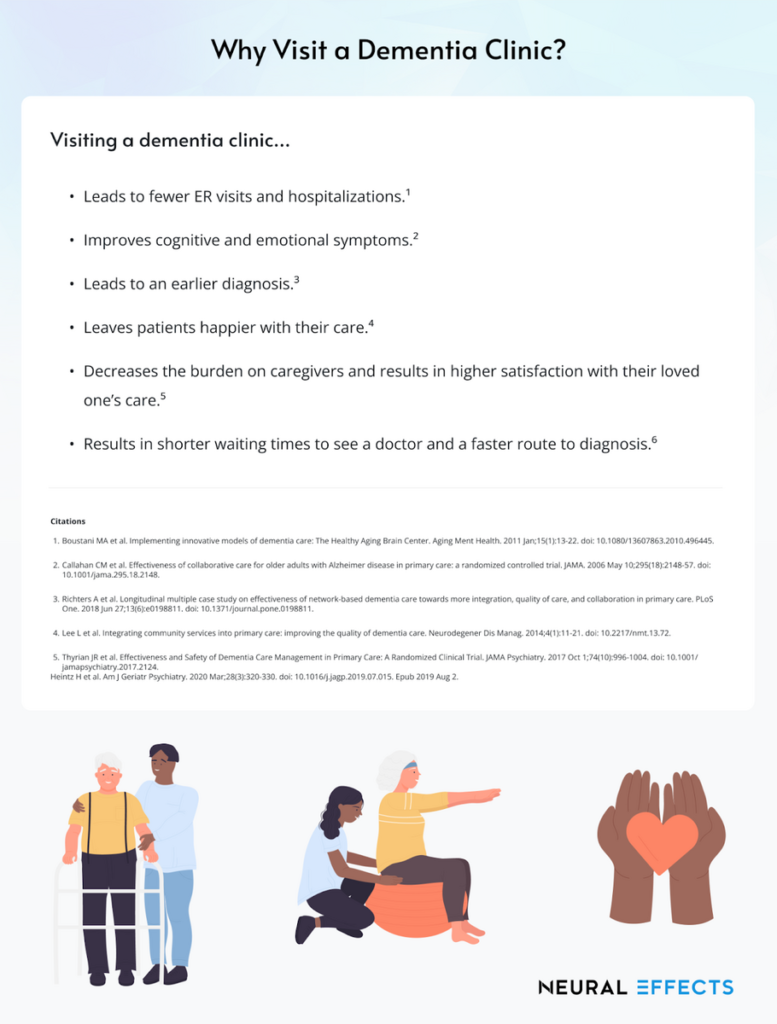
As we mentioned in the introduction, visiting a dementia clinic can help extend autonomy and quality of life for patients with dementia, as well as support family members and caregivers with helpful advice and resources.
To learn more about what to look for in a dementia clinic, read this past article.
At our clinic, Neural Effects, we use a combination of cognitive stimulation therapy (CST) and aerobic exercise to boost the effect of therapy and help delay the progression of symptoms. Our healthcare professionals use or recommend many of the therapeutic activities suggested here.
Before treatment starts, patients undergo a dementia evaluation, which includes a neuropsychological exam (also called a neurocognitive evaluation) to find out exactly how dementia has affected their brain, as well as a physical, cognitive, and emotional assessment. This exam takes about 2–2.5 hours to complete.
Even if patients already have a dementia diagnosis, they still need to complete this exam. We feel it provides useful information to guide our therapists regarding important treatment decisions. If patients don’t have a diagnosis yet, we coordinate with their neurologist to investigate whether they have dementia and, if so, what type.
All information gathered is then combined into a cognitive care plan (CCP). Each patient gets a personalized dementia care plan, even if they decide not to continue treatment with us. And for patients who don’t have dementia, the CCP still includes important recommendations that can help protect their cognitive health in the future.
The CCP includes the following health information:
- Diagnosis
- Results from the assessment
- Risk factors for progression and discussion of how the disease is likely to progress
- Lifestyle changes that may help the patient
- Suggestions for family involvement
- Recommended treatment options
After the exam, patients can start their therapy sessions. Our program includes two sessions per week for seven weeks, for a total of 14 one-hour sessions.
To start each session, patients engage in 10–15 minutes of aerobic exercise, usually done on a stationary bike or treadmill. Our therapists are trained to adapt the exercises in intensity and duration to ensure patients stay safe. We use physical exercise because it stimulates the flow of blood in the brain. It also promotes the release of a crucial neurochemical cascade, including one compound called brain-derived neurotrophic factor (BDNF). BDNF makes the brain more receptive to therapy and helps patients learn better.

After exercise, patients engage in various cognitive activities to stimulate thinking and memory, including discussing past and present events, word games, puzzles, music, and practical activities. Some of the activities we use were described previously (in activity #13: Cognitive Games Used in Therapy).
The sessions are organized and run by two facilitators working with a small group of up to six patients. These facilitators guide the discussions and help patients socialize with each other.
We understand how important the support of family members is for patients with dementia. For this reason, we invite relatives and caregivers to attend the first session to learn more about the treatment. They can then support patients by repeating some of the activities and games at home.
Our staff also educates family members about lifestyle changes that may help the patient, including eating a balanced diet, engaging in regular exercise, and maintaining an active social life. Finally, loved ones receive follow-up resources, including suggestions for support groups in their area for both patients and their caregivers.
Neural Effects uses the latest evidence-based techniques to diagnose and help patients with dementia. We are located in Provo, Utah, and serve anyone in Salt Lake City or the Utah Valley area. We are in-network for most types of medical insurance. Schedule your evaluation today.
